|
|
 |
|
Monstrilloida ( Order ) |
|
|
|
Monstrillidae ( Family ) |
|
|
|
Monstrillopsis ( Genus ) |
|
|
| |
Monstrillopsis ferrarii Suarez-Morales & Ivanenko, 2004 (F) | |
| | | | | | | Ref.: | | | Suarez-Morales & Ivanenko, 2004 (p.38, figs. F); Suarez-Morales & al., 2006 (p.101, 106, Tab.1) | 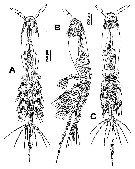 issued from : E. Suarez-Morales & V.V. Ivanenko in Arctic, 2004, 57 (1). [p.39, Fig.2]. Female (from White Sea): A-C, habitus (dorsal, lateral and ventral, respectively). Nota: The 1st pedigerous somite is cephalically incorporated. Urosome with 4 somites
|
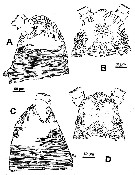 issued from : E. Suarez-Morales & V.V. Ivanenko in Arctic, 2004, 57 (1). [p.39, Fig.3]. Female: A, cephalic area (lateral; showing cuticular ornamentation); B, idem (dorsal; showing cuticular protuberances and ornamentation); C, cephalic area (lateral; paratype); D, idem (dorsal; paratype). Nota: Oral papilla slightly protuberant, located less than 21 % of way back along ventral surface. Pair of ocelli present, with pigment cups medially conjointed, well developed. Cephalic segment with irregular cuticular protuberances on forehead. Sensilla not observed on cephalic area.
|
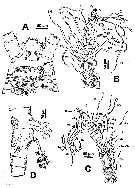 issued from : E. Suarez-Morales & V.V. Ivanenko in Arctic, 2004, 57 (1). [p.40, Fig.4]. Female: A, cephalic area (ventral); B, right A1 (dorsal; with some elements identifid following the nomenclature of Grygier & Ohtsuka, 1995); C, left A1 (dorsal); with complementary labels of antennular elements); D, 1st pedigerous somite, genital double-somite, and two free urosomites (lateral).
|
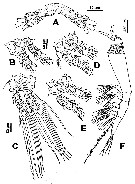 issued from : E. Suarez-Morales & V.V. Ivanenko in Arctic, 2004, 57 (1). [p.40, Fig.5]. Female: A: P5 (ventral view); B, P1; C, P2; D, P3; E, P4; F, habitus (lateral). A, F: paratype; B-E: holotype. The setae of swimming legs 1, 3 and 4, 5 are cut short. Nota: A1 4-segmented
|
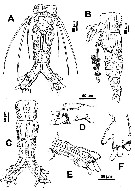 issued from : E. Suarez-Morales & V.V. Ivanenko in Arctic, 2004, 57 (1). [p.41, Fig.6]. Female: A, urosome including 5th pedigerous, genital double-somite, and two free somites (ventral); B, idem (lateral); C, idem (dorsal); D, P5 (lateral view); E, idem (lateral view); F, idem (anterior view). A, C, D, F, holotype; B, E: paratype. Nota: P5 medially conjointed at the base and unsegmented, each consisting of a relatively large outer (exopodal) lobe and an inner (endopodal), digitiform, amost thumb-shaped lobe; the endopodal lobe reaches at most the distal margin of the exopodal lobe; 3 exopodal setae present, all unusually long, the outermost two longest, reaching the level of the proximal 1/3 of the caudal rami; the innermost seta slightly thinner and abour 35 % shorter than the outer ones; all 3 setae biserially and sparsely setulated.
|
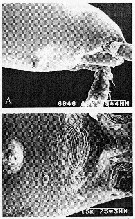 issued from : E. Suarez-Morales & V.V. Ivanenko in Arctic, 2004, 57 (1). [p.41, Fig.7]. Female: A, semilateral view of anterior part of cephalothorax (showing posteriorly fading cuticular pattern); B, detail of anterior-ventral cuticular processes and wrinkles. Scale bars = 0.100 mm in A and 0.045 mm in B.
|
 issued from : E. Suarez-Morales & V.V. Ivanenko in Arctic, 2004, 57 (1). [p.42, Table 1]. Comparison of taxonomic features and morphometry in females of selected species of Monstrillopsis. A1 = antennule; AN = anal somite; CT = cephalothorax; FP = 1st pediger; GS = genital double-somite; LA = last antennular segment; TL = total length; UR = urosome. All ratios are presented in percentage form.
|
 Issued from : E. Suarez-Morales, A. Bello-Smith & S. Palma in Zool. Anz., 2006, 245. [p.103, Table 1]. Structural characteristics. Morphological characters for comparative morphology of the species assigned to the genus Monstrillopsis by different authorities. See : dubioides, M. fosshageni, M. reticulata, M. sarsi, Cymbasoma gracilis, M. dubia, M. zernovi, M; angustipes, Monstrillopsis sp. Key for the identification of the currently known species of Monstrillopsis (female only) after Suarez-Morales & al. (2006, p.105): 1 - Outer lobe of P5 without distal elongation; last antennular segment less than the 45% of A1 length ; body length less than 3 mm...... 2. 2 - Anterior half of 5th pedigerous soùmite laterally protuberant; lateral margins of genital double-somite expanded proximally; A1 representing less than 20% of total body length; 4 caudal setae...... 3. 4 - Outer and middle exopodal setae of P5 equally long, inner seta relatively long, slightly shorter than other two setae; dorsal cephalic surface strongly corrugated; urosomal somites with well-developed pattern of cuticular wrinkles; body length over 2.5 mm.
| | | | | Compl. Ref.: | | | Suarez-Morales, 2011 (p.12) | | | | NZ: | 1 | | |
|
Distribution map of Monstrillopsis ferrarii by geographical zones
|
| | | | Loc: | | | Arctic : White Sea (Kandalaksha Bay) | | | | N: | 1 | | | | Lg.: | | | (939) F: 1,98-2,56 [without Furca]; {F: 1,98-2,56} | | | | Rem.: |
See remarks in Suarez-Morales & al. (2006, p.101) concerning comparison with M. chilensis. | | | Last update : 07/03/2020 | |
|
|
 Any use of this site for a publication will be mentioned with the following reference : Any use of this site for a publication will be mentioned with the following reference :
Razouls C., Desreumaux N., Kouwenberg J. and de Bovée F., 2005-2025. - Biodiversity of Marine Planktonic Copepods (morphology, geographical distribution and biological data). Sorbonne University, CNRS. Available at http://copepodes.obs-banyuls.fr/en [Accessed December 28, 2025] © copyright 2005-2025 Sorbonne University, CNRS
|
|
 |
 |










